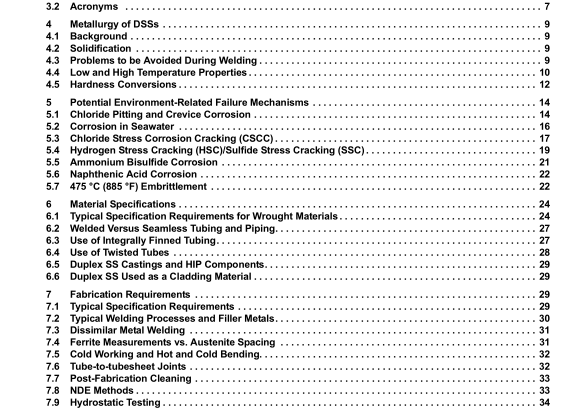API TR 938-C:2015 pdf free download.Use of Duplex Stainless Steels in the Oil Refining Industry
4 Metallurgy of DSSs 4.1 Background To achieve the proper specification of the materials combined with proper fabrication and welding practices in order to obtain the expected toughness and corrosion resistance, an understanding of the metallurgical structure of DSSs and the effects of various treatments on that structure is needed. Therefore, the metallurgy of DSSs is one of the first topics covered in this report. The subsequent discussion covers the resistance of DSSs to specific degradation mechanisms and generally assumes properly produced and fabricated base materials and welds unless otherwise indicated. Both the early and current grades of DSSs have good localized corrosion resistance in the annealed condition because of their high chromium and molybdenum contents.
When the first generation duplex grades were welded, however, they lost the optimal phase balance. Excessive ferrite and precipitated sigma phase in the weld and weld HAZ adversely affected both corrosion resistance and toughness. This problem was overcome in the 1980s by the addition of nitrogen, which achieved a better balance between austenite and ferrite. Nitrogen was initially added as an inexpensive austenite former. However, this addition quickly showed other benefits, including retarded sigma phase precipitation, improved toughness, tensile and yield strength, and improved pitting and crevice corrosion resistance. Close attention to the weld procedure is still necessary to obtain the optimum results.
4.2 Solidification DSSs solidify as a fully ferritic structure and then with further cooling, some of the ferrite transforms to austenite within the ferritic structure. Nitrogen raises the temperature at which the austenite formation begins. This allows the equilibrium level of austenite and the desired phase balance to be achieved, even at relatively rapid cooling rates. This favorable effect occurs during solidification, as in casting and welding, and in annealing and other high temperature exposures, such as the HAZ during welding. It reduces the risk of excess ferrite in the HAZ, as discussed in 4.3.
In some grades of DSS, the partitioning of the some alloying elements such as Cr, Ni, N, or Mo, can lead to differences in the corrosion resistance between the phases to certain environments. For example, Selective Austenite Attack has occurred on S32205 DSS in certain types of Flue Gas Desulfurization (FGD) units, while other services have had Selective Ferrite Attack. This is discussed further in 5.1 and 5.5. Although partitioning depends on both the chemistry and the thermal history, Table 4 shows partitioning test results of various grades [40] .
4.3 Problems to be Avoided During Welding
There are two primary problems to be avoided when welding DSSs, namely:
1) excessive ferrite in the HAZ or weld deposit;
2) formation of harmful intermetallic phases (such as sigma phase or chi phase, which are complex compounds of iron, chromium, and molybdenum) in the HAZ and weld deposit.
High ferrite contents can result from extremely low heat input welding or from extremely rapid quenching. Rapid quenching is damaging to DSSs if it causes the steel to remain mostly ferritic as it cools from the high temperature exposure. The effect of higher nitrogen content is to promote rapid formation of austenite, making the DSSs less sensitive to this problem. In virtually every case, the quenching rates fast enough to cause excessive ferrite are due to low heat input welds performed on heavy sections, with the conduction in the workpiece itself providing the rapid quench. Resistance welds, welds of sheet liners to plates, or tube-to-tubesheet welds are examples of situations susceptible to extremely rapid cooling. Another example has been small wash passes on large welds that have cooled to ambient temperature.API TR 938-C pdf download.API TR 938-C:2015 pdf free download
